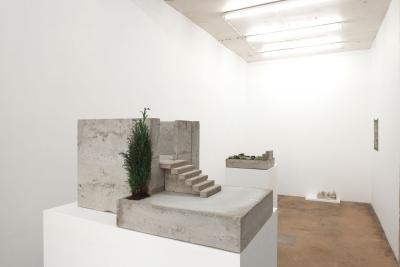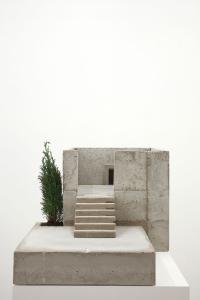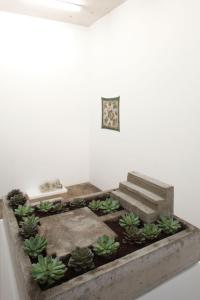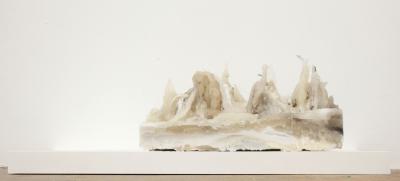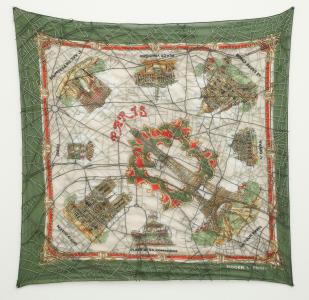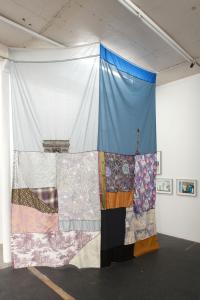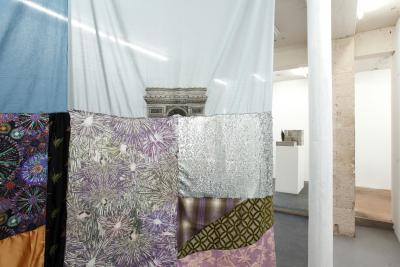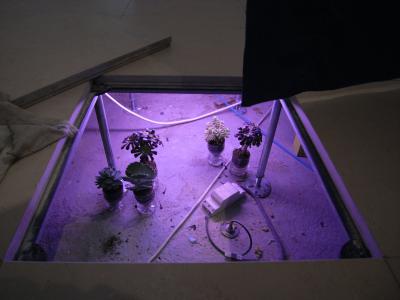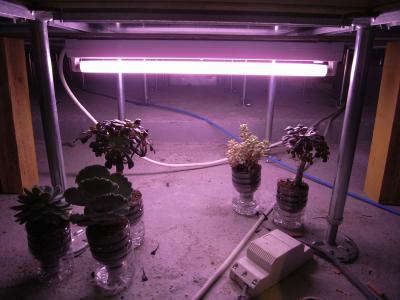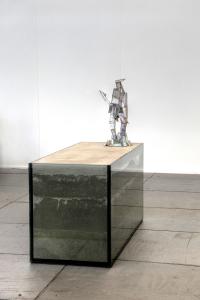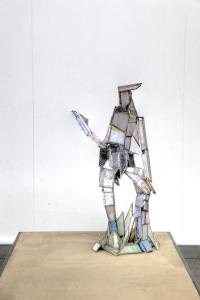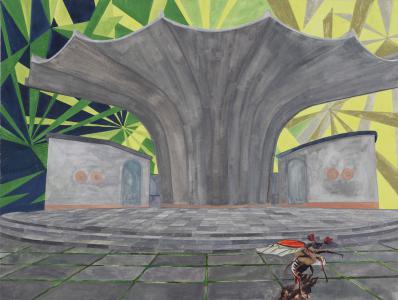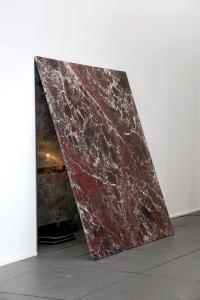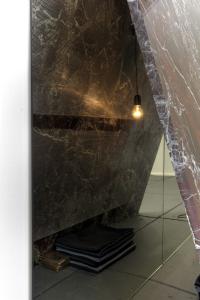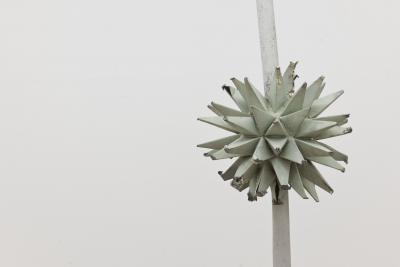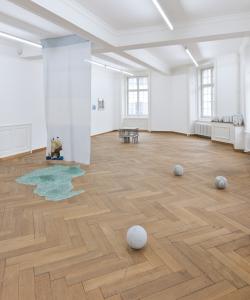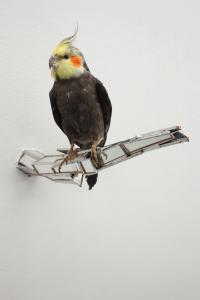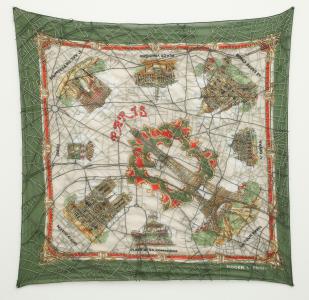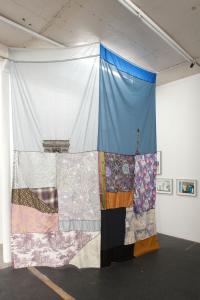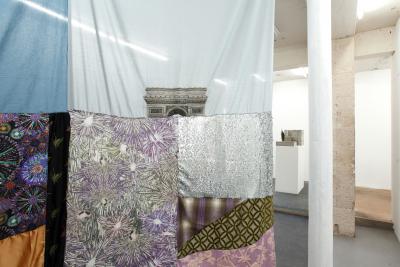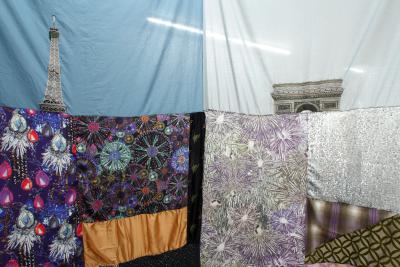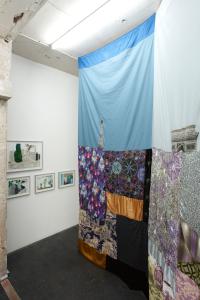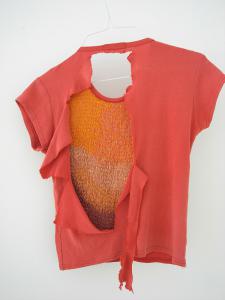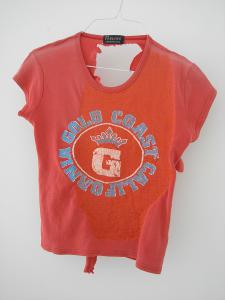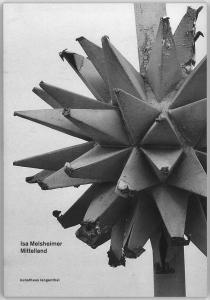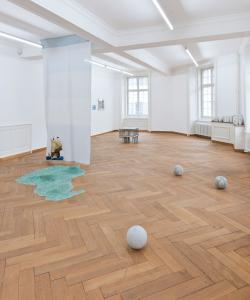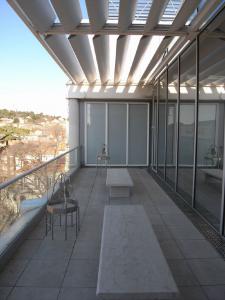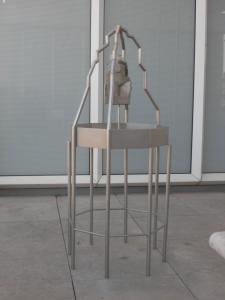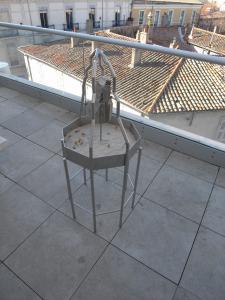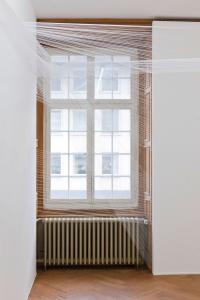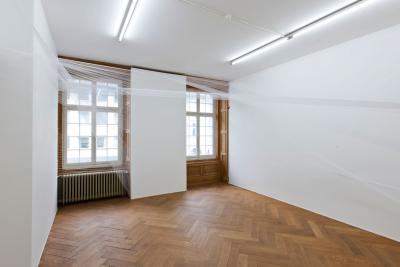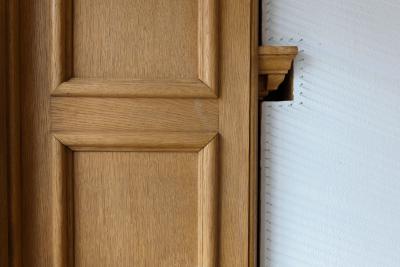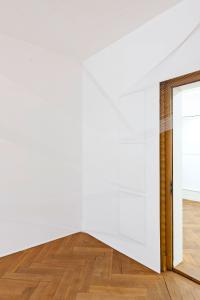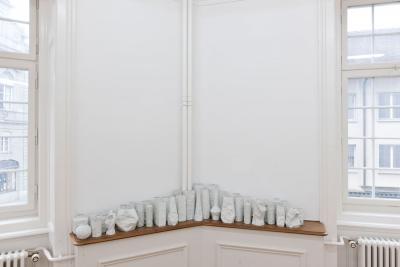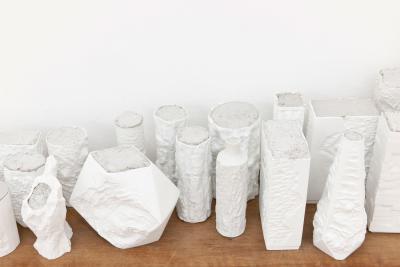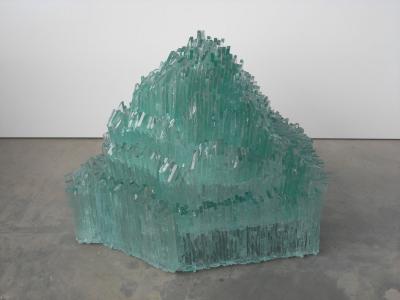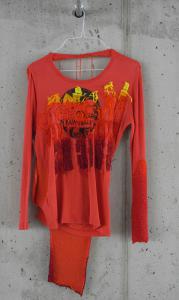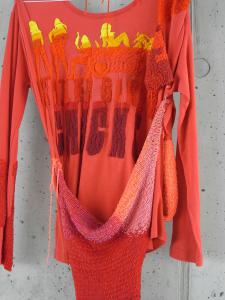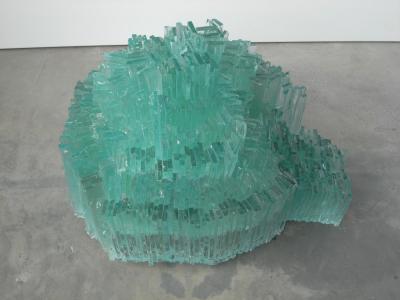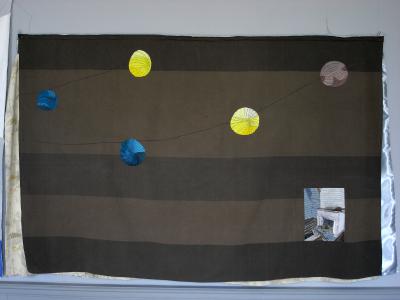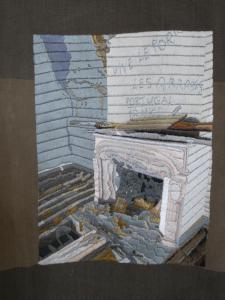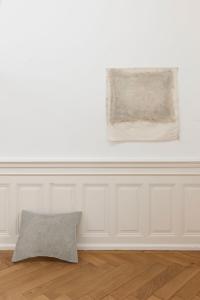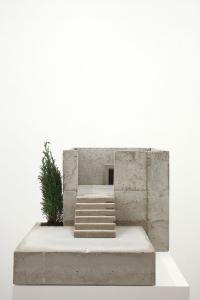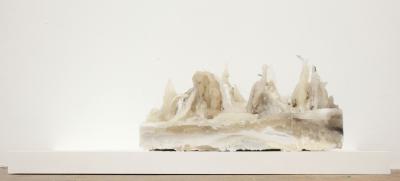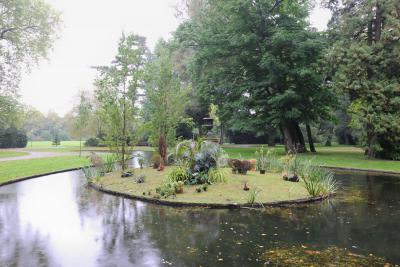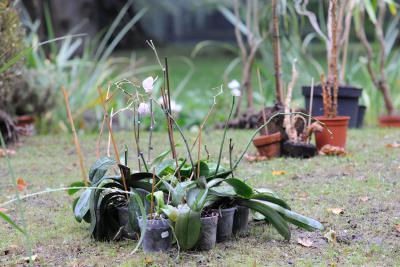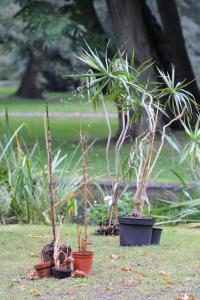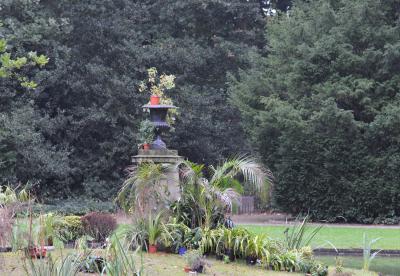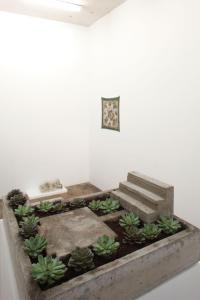Freedom. A Poem. A Home.
By Fanni Fetzer
“Bettine, who seems to know everyone and is darting back and forth among the various groups, catches up with them, and in a mischievous frame of mind asks what they would wish for if they had three wishes and could wish for anything they liked. Günderrode laughs: I’ll tell you later. She knows of no wish she could make, her wishes are boundless.
And you, Kleist?
Kleist says: Freedom. A poem. A home.
Irreconcilable things which you want to reconcile.
Yes, he says lightly. I know.”1
Isa Melsheimer has set up a dense mesh of threads extending through three rooms and seeming to twist about itself. The work “Hyperboloïde III” (2010), inspired by the elegant shell buildings by Swiss engineer Heinz Isler (1926–2009), is as aesthetic as it is fleeting; the thread will only stretch from nail to nail for the duration of the exhibition. That Isa Melsheimer chose these three particular exhibition rooms for her installation is quite in keeping with the artist’s sense for buildings. Architecture’s struggle in the listed Kunsthaus building is particularly evident in these rooms. Here a piece of the panelling rises up from behind a lining wall, a cable snakes its way along a breast wall, or else cracks appear in an area of facing. There is an analogy, in Isa Melsheimer’s view, between the architecture she found at the Kunsthaus Langenthal and society’s handling of Heinz Isler’s concrete shells.
The general public is scarcely aware of Heinz Isler, although he is very much revered on the architecture scene and his shells are distributed densely around the Swiss Mittelland. His elegant buildings are much loved by experts in the field because of their large free spans, yet the great majority of people fail to even notice them. Isler’s concrete shells, grey, subtle and modest, fade into industrial zones and so are not often recognized as masterly achievements by a building pioneer. The fact that Heinz Isler was an engineer and not an architect further prevents his œuvre from gaining appropriate recognition outside a specific circle of experts. One exception is the motorway services stop Deitingen-Süd. It is a listed building whose survival is guaranteed by prominent architects. Isa Melsheimer sees a parallel in such anecdotes to the biography and reception of the works of Ulrich Müther (1934–2007), who caused a similar sensation in the GDR with concrete shell buildings, but is just as largely forgotten or ignored today.
Ulrich Müther’s buildings, not only amazing structures in his day but also astonishing achievements from today’s perspective, were a source of inspiration for Isa Melsheimer from an early date. She translated Müther’s complex curved forms into light, space-filling meshes of threads. This complicated transformation of an existing architectural form into a delicate fragile artwork is characteristic of Isa Melsheimer’s working method. The artist is interested not in the technical aspects of a building, but in its aesthetics, and she herself does not shy away from creating visually attractive works. The theme that preoccupies her is why architecture such as that of Müther and Isler is not widely recognized.
A respectful treatment of the shell buildings, as part of the cultural heritage, is hindered because of a total misunderstanding of an architecture whose stringent minimalism and greatest possible material efficiency do not represent the spectacular. Where does this indifference, this disregard originate?
In the exhibition “Mittelland” at the Kunsthaus Langenthal, Isa Melsheimer, who has also always been interested in the history of buildings, confronts the works of Ulrich Müther and Heinz Isler. While Isler’s motorway services stop is under protection, most of his other buildings remain ignored. And although Ulrich Müther gave the spa of Binz on the Baltic Sea island of Rügen an architectural icon with his life-guard station, Strandwache 1, many of his shell buildings are either decaying or earmarked for demolition so as to make way for a new touristic infrastructure. Isa Melsheimer refers to these kinds of complex architectural and economic links in her installation in the Kunsthaus Langenthal. On the floor of the exhibition room she reconstructs the Grosse Jasmunder Bodden, the venue in Ralswiek for the annual Störtebeker Festival, whose director has complained about the proximity of Müther’s ‘ugly’ shells to the festival site. On the embroidered cloth “Holzgitterschale/Rügen” (2010) over the glass lake we see a festival stage in the form of a pirate ship; behind the fabric we can make out the outline of a shell building by Müther, “Gaststätte Inselparadies” (2010). As with her thread mesh, the artist succeeds in sensitively linking the captivating, if massive, concrete architecture with the fine medium of embroidery.
Isa Melsheimer also integrates the cladding of a radiator between the windows, a further indicator of the clumsy handling of the architecture of the Kunsthaus Langenthal. The biscuit china vases stand for Rügen’s world-famous chalk cliffs, but they are filled to the brim with concrete, just as the once risky path across the cliffs and down to the beach has been reconstructed for tourists, i.e. for older people, complete with concrete steps and a handrail. Isa Melsheimer again questions the social reasons why the natural miracle of the chalk cliffs – appropriated by tourism – has been robbed of its naturalness, while the pioneering spirit in Müther’s concrete shells is ignored. Isa Melsheimer underscores the experimental character of Isler’s and Müther’s shells in her own small concrete models. Whereas Müther cast his shells with his own hands in the form-giving sand of the beach, Isler tried to generate the right (right because observed in nature and not calculated mathematically) form for his shells in his garden using ice and textiles. Isa Melsheimer too constructs the forms herself, pouring the concrete and waiting patiently for a week to see what the result is. Fragments, failed static attempts, are therefore as much
a part of the work as are the finished adaptations. Whether the form holds or breaks, Isa Melsheimer succeeds in wresting a unique poetry from the building material concrete. Even for those who find its use in everyday life of little appeal, her works may well provide access to, if not engender a love of concrete.
Which subjects are socially admired, why is there so much bad architecture in European cities, and why are people moving from the city to the country? Which longings, aesthetic preferences and ideologies are manifest in our buildings? Isa Melsheimer has always been interested in architecture. She likes to view houses, read about architectural theory, and is generally inquisitive about how we live and why. Concealed behind these questions, which can also be answered purely formally, is an astute political awareness of the fact that architecture always stands for something – an ideology, concepts, an environment built in a form we have chosen or at least condoned. Although architecture, especially classical modern architecture and buildings dating from the 1960s, is a theme that attracts the artist, she has no wish to build herself. However she knows the feeling of falling in love with a building, a house by Le Corbusier or Mies van der Rohe. Isa Melsheimer approaches these icons of modernism by means of gouaches, objects made of glued glass and embroidered curtains. She chooses media which she herself can physically master, whereby she as a woman is not interested in embroidering, but rather in handicrafts in and for themselves. The cultural-historical significance of embroidery is so closely entwined with gender history that it seems almost impossible to view embroidery without making reference to this. Isa Melsheimer adopts embroidery purely as a craft. When embroidering, she does not refer to feminist positions in art. Her feminism emerges at most in a critical attitude towards aesthetic statements, and not in her processing of textile materials. For Isa Melsheimer, the fabric itself, unlike an empty white canvas, already has a high degree of materiality, added to that the yarn, the organic thread, and the considerable amount of time demanded by embroidery work. She seeks the slowness of the medium and, while embroidering, gains time for thought or acoustic books. She confronts the massive icons of architectural history not with equally massive artworks, but with this hand-crafted material which in itself already questions architecture. Instead of responding to large buildings with large works, she facilitates narrative and also speculation. Yet she always exposes these ascriptions. She pursues different viewpoints, and the minutiae of her art harbour the potential for diverging readings. The artist thus brings together the summer festival on Rügen and the criticism of Ulrich Müther’s concrete shells, or else transports the beauty of Heinz Isler’s developed views to the Kunsthaus Langenthal – and perhaps will thus succeed in enabling us to perceive his shells in our immediate surroundings in the future.
Isa Melsheimer nevertheless remains critical of the figures, the architects, and opposes the vanities of the heroes of architectural history to her own often narrative but never massive works. In “Battle Lines” (2010) 2 Isa Melsheimer takes up the tragic anecdote about the designer Eileen Gray, whose outstanding summer house on Cap Martin was decorated with suggestive pictures by Le Corbusier during her absence and without her permission, whereupon Eileen Gray never set foot inside the house again.3 Le Corbusier’s characteristic lines from that mural painting are embroidered in such as way that his handwriting is always clearly recognisable, but his insolent intervention in the house of his designer-friend is unmasked as being both chauvinistic and stupid. The work criticises not the artist Le Corbusier’s buildings, but his actions. This is done quite subtly, and thereby restores the house to Eileen Gray.
The biscuit china vases purchased by auction on the Internet (“Rügen”, 2010) or the star brought back from Rügen (“Stern/Rostock/Riga”, 2010) are found objects of a kind which Isa Melsheimer only rarely uses in her work. Yet “Stern/Taschkent” (2009) is, in the broadest sense, also an objet trouvé, discovered on an architectural trip to Uzbekistan, but too heavy to transport and therefore only brought back as an idea and copied. The origins of the object “ohne Titel (Istanbul)” 2008 are more veiled.
Its abstraction evokes associations with Istanbul’s multifaceted 1960s architecture, but in fact it relates to the clumsy, because self-cast, Turkish parking space obstructions. What all these works have in common is the great care with which Isa Melsheimer transforms and preserves old, forgotten and unheeded forms and materials in her work. The artist handles the concrete shells by Müther and Isler in a similar way, albeit on a larger scale. Yet it would be wrong to assume that she only devotes herself to outsider positions and only scrutinizes small architectural irrelevancies. With the same poetic licence she also adapts Frank Lloyd Wright’s Waterfall House (“Felsen”, 2006) or Mies van der Rohe’s Barcelona Pavilion (“Sitzgruppe mit Onyxwand”, 2008) while at the same time addressing the theme of the process of aesthetic opinion-formation as the consensus of a whole generation.
In doing so she does not express a critique of the material (onyx, in the case of the Barcelona Pavilion), but instead illustrates how discursive an aesthetic judgement could also be if only we would form our own opinion – for what is considered a major achievement in one context, stands for bad taste in another.4
The artist very subtly dismantles heroes like Le Corbusier or Sir Normal Foster. She only succeeds in doing this because these great architects already made such forceful claims with their buildings.
“Exit” (2009), is a small piece of embroidery which Isa Melsheimer simply hung beside the service hatch of an air vent, thus quietly indicating an architectonic deficiency, a constructed inconsistency, in Sir Norman Foster’s Museum Carré d’Art in Nimes.5 Yet she does not place herself above her subject, i.e., architecture. Instead she provides us with small indications of how something could be seen differently. She does not make fun of anyone or anything, and she is not being didactic when she challenges us to look again, to look differently, to recognize the form and ultimately, to build differently. This attitude is liberating because it aims to encourage us to form and express our own opinion – even about so-called great architecture, and also in our treatment of supposedly
insignificant everyday architecture.
Isa Melsheimer’s nimble, poetic works bring together what Heinrich von Kleist, in the opening quotation, considered irreconcilable, but very desirable – freedom, a poem, a house. She achieves this because she herself makes no massive claims, but instead subtly directs us to alternative readings, speculative stories, and prompts us to look ourselves, to form and express an opinion. Freedom. A Poem. A Home.
1 Christa Wolf: No place on earth, New York, 1982, ed. 2010, p. 86.
2 Isa Melsheimer’s contribution to the group exhibition
“Living Rooms / Pieces à vivre”, Château Chamarande, France, 30.5.–3.10.2010.
3 See Beatriz Colomina, “War on Architecture, E.1027 – House
designed by Eileen Gray at Cap Martin, France”, in Assemblage 20, 1993, p. 28f.
4 Exhibition “Isa Melsheimer – Kunstpreis der Stadt Nordhorn 2008”,
Städtische Galerie Nordhorn, 6.9.–19.10.2008. A central part
of the installation was a band of onyx amphoras corresponding to
the precise measurement of the load-bearing wall in Mies Van
der Rohe’s famous Barcelona Pavillion. Whereas Van der Rohe’s onyx
wall is regarded as a great moment in the history of architecture,
the vases of the same material are like tawdry souvenirs of holidays
in the south.
5 Exhibition “Isa Melsheimer”, Carré d’Art – Musée d’art contemporaine de Nîmes, 26.1.–18.4.2010.
The museum designed by Sir Norman Foster is characterised by white cubes hanging in
a load-bearing construction. But the idea of a perfect white cube
is undermined by numerous technical details. Isa Melsheimer
pointed to this somewhat bizarre discrepancy between aspiration
and reality by means of different little artistic interventions.
